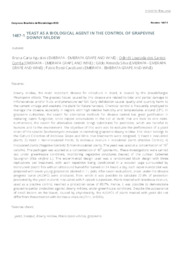Yeast as a biological agent in the control of grapevine downy mildew.
Yeast as a biological agent in the control of grapevine downy mildew.
Autoria: AGUSTINI, B. C.; CORREA, O. L. dos S.; SILVA, G. A.; CAVALCANTI, F. R.
Resumo: Downy mildew, the most important disease for viticulture in Brazil, is caused by the pseudofungus Plasmopara viticola. The greatest losses caused by this disease are related to total and partial damage to inflorescences and/or fruits and premature leaf fall. Early defoliation causes quality and quantity harm to the current vintage and weakens the plant for future harvests. Chemical control is frequently employed to manage the disease, especially in regions with high relative humidity and temperatures around 23°C. In grapevine cultivation, the search for alternative methods for disease control has great justification in replacing cupric fungicides, since copper accumulates in the soil at levels that are toxic to vine roots. Furthermore, the search for alternative controls brings substitutes for pesticides, which are harmful to humans and to the environment. The objective of this work was to evaluate the performance of a yeast strain of the species Saccharomyces cerevisiae in controlling grapevine downy mildew. This strain belongs to the Culture Collection of Embrapa Grape and Wine. Five treatments were designed: 1) Yeast + Inoculated plants; 2) Yeast + Non-inoculated Plants; 3) Bordeaux mixture + Inoculated plants (Positive Control); 4) Inoculated plants (Negative Control); 5) Non-inoculated plants. The yeast was used at a concentration of 10 5 cells/mL. The pathogen was applied at a concentration of 10 5 spores/mL. These investigations were carried out under reenhouse conditions, monitoring vegetative structures (leaves) of the cultivar Cabernet Sauvignon (Vitis vinifera L.). The experimental design used was a randomized block design with three eplications per treatment, with each repetition being conditioned in a wooden cage surrounded by translucent plastic film with an ultrasound humidifier turned on 24 hours a day. Each experimental plot was prepared with seven young grapevines planted in 1 L pots. After seven evaluations, areas under the disease progress curve (AUDPC) were produced, from which it was possible to calculate 72.6% of protection promoted by the yeast in plants inoculated with P. viticola suspension. Plants treated with Bordeaux mixture, used as a positive control, reached a protection value of 89.7%. Hence, it was possible to demonstrate grapevine partial protection against downy mildew, under greenhouse conditions. Despite the appearance of small lesions on the leaves, caused by phytotoxicity, the AUDPCs of plants treated with yeast did not differ from those treated with Bordeaux mixture (Ctrl+, p>0.05).
Ano de publicação: 2023
Tipo de publicação: Resumo em anais e proceedings
Unidade: Embrapa Uva e Vinho
Palavras-chave: Bionput, Downy mildew, Grapevine, Plasmopara viticola, Yeast
Observações
1 - Por padrão são exibidas publicações dos últimos 20 anos. Para encontrar publicações mais antigas, configure o filtro ano de publicação, colocando o ano a partir do qual você deseja encontrar publicações. O filtro está na coluna da esquerda na busca acima.
2 - Para ler algumas publicações da Embrapa (apenas as que estão em formato ePub), é necessário ter, no celular ou computador, um desses softwares gratuitos. Sistemas Android: Google Play Livros; IOS: iBooks; Windows e Linux: software Calibre.
Acesse outras publicações
Acesse a Base de Dados da Pesquisa Agropecuária (BDPA) para consultar o acervo completo das bibliotecas da Embrapa.

